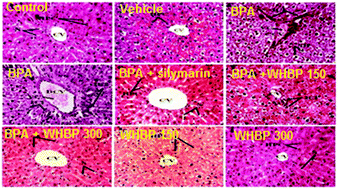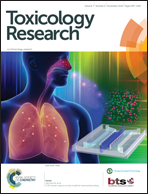In vitro antioxidant efficacy and the therapeutic potential of Wendlandia heynei (Schult.) Santapau & Merchant against bisphenol A-induced hepatotoxicity in rats
Abstract
The aim of present study was to access the antioxidant and ameliorative efficacy of Wendlandia heynei stem bark's crude methanol extract (WHBM) against bisphenol A (BPA)-induced hepatotoxicity in the rat moel. WHBM and its derived fractions exhibited promising activity for the scavenging of DPPH, hydroxyl and nitrite radicals, iron chelation, and for the inhibition of β-carotene oxidation. The administration of BPA to Sprague Dawley rats (25 mg kg−1) for 28 days resulted in an elevated (p < 0.01) level of aspartate transaminase, alanine transaminase, alkaline phosphatase, and globulin, and at the same time a decrease (p < 0.01) in the level of total protein and albumin in the serum of the rats. In hepatic samples, the levels of catalase, peroxidase, superoxide dismutase, glutathione-S-transferase, and reduced glutathione were decreased (p < 0.05), whereas thiobarbituric acid reactive substances, hydrogen peroxide, and the nitrite content were increased (p < 0.05) with BPA treatment to the rats. The administration of WHBM to BPA-intoxicated rats restored the altered levels of these parameters toward the control animals. Histopathological alterations of the hepatic tissues induced with BPA were restored with WHBM co-treatment to the rats. HPLC-DAD analysis ensured the occurrence of rutin, catechin, and caffeic acid in WHBM and WHBE. The results of this study suggested that the presence of phenolics and flavonoids in W. heynei bark might be responsible for it exhibiting antioxidant potential during the in vitro and in vivo studies and hence it has potential to be used as a therapeutic agent against oxidative stress associated diseases.



 Please wait while we load your content...
Please wait while we load your content...